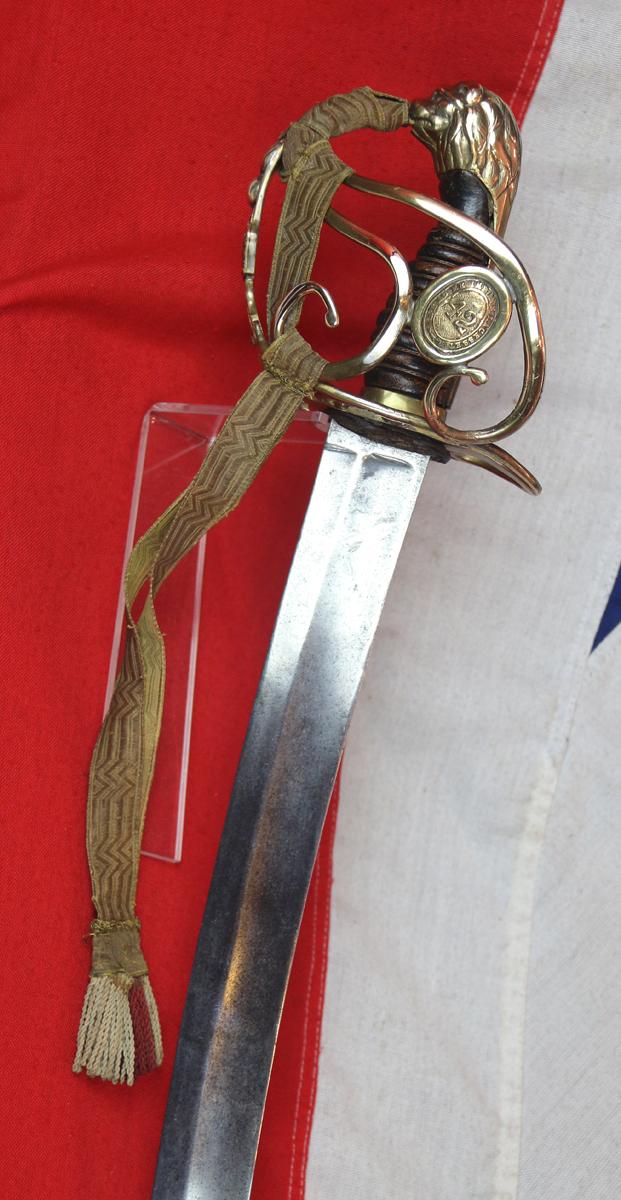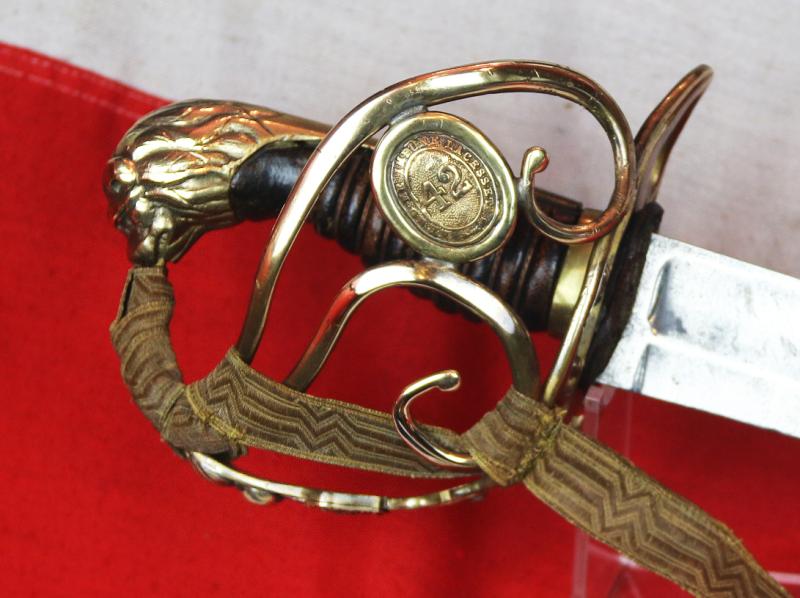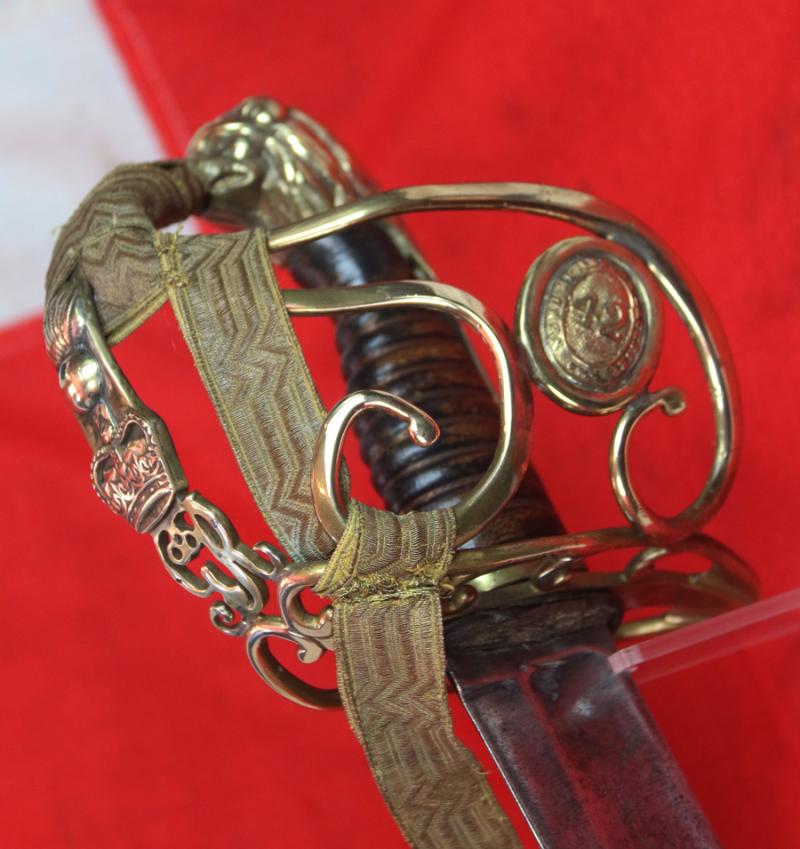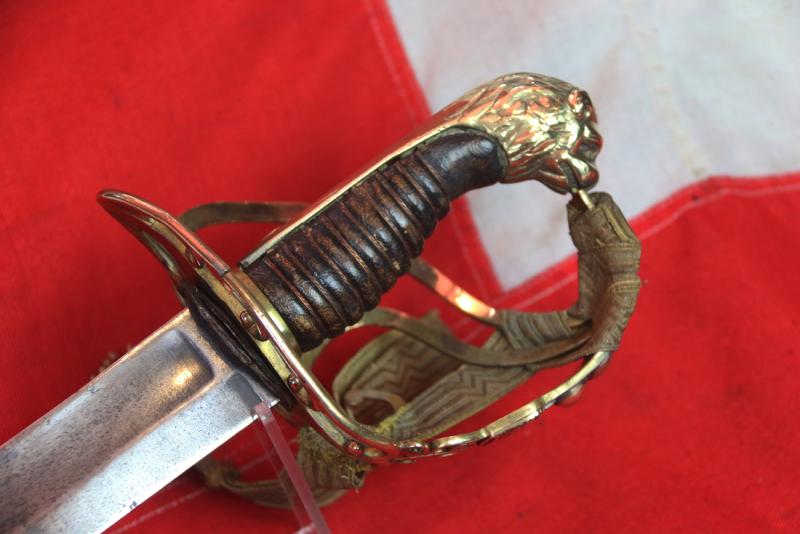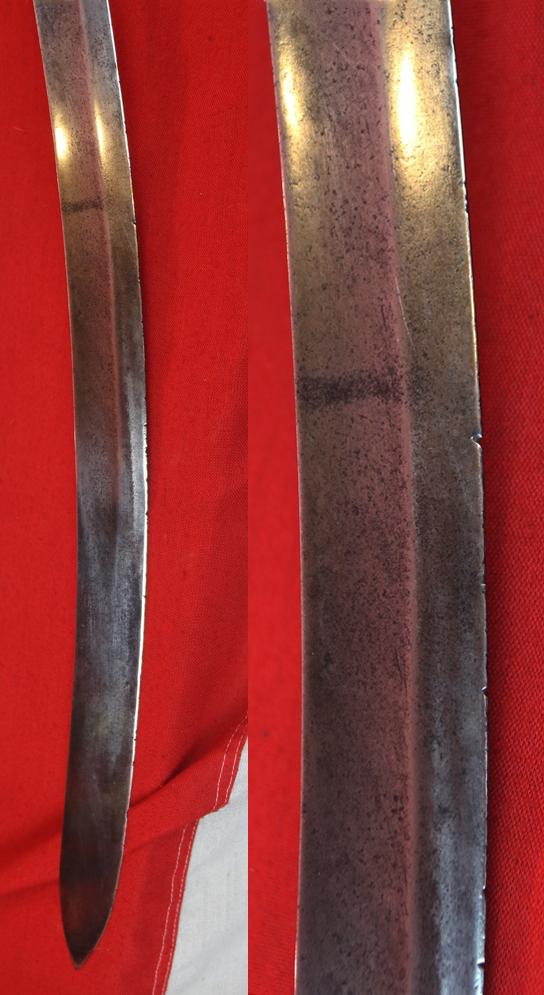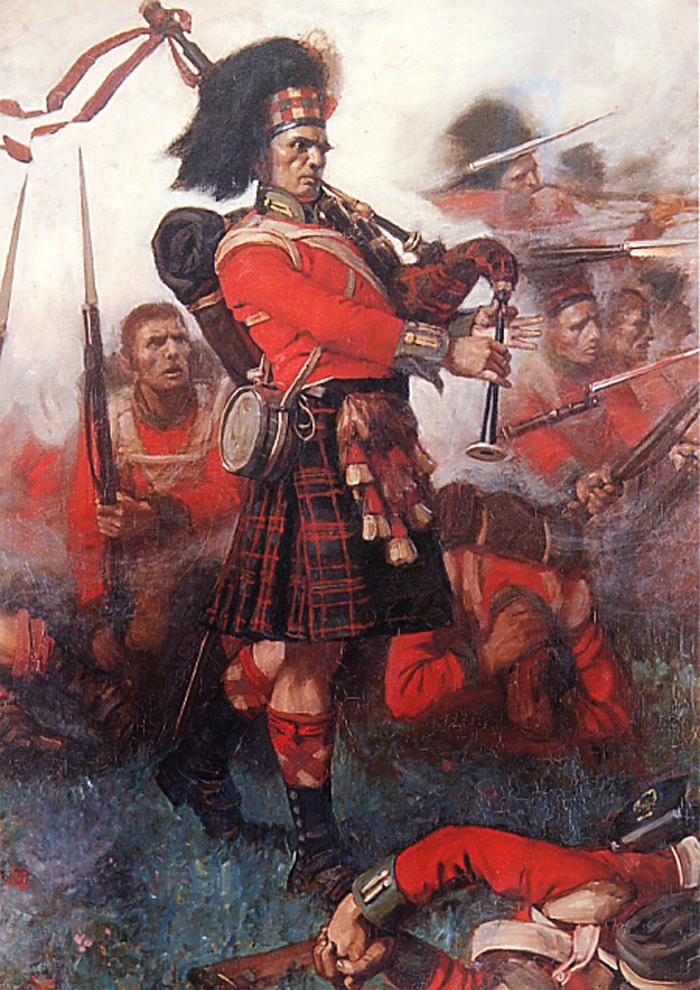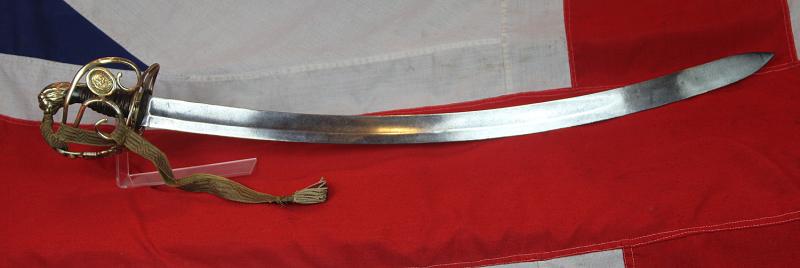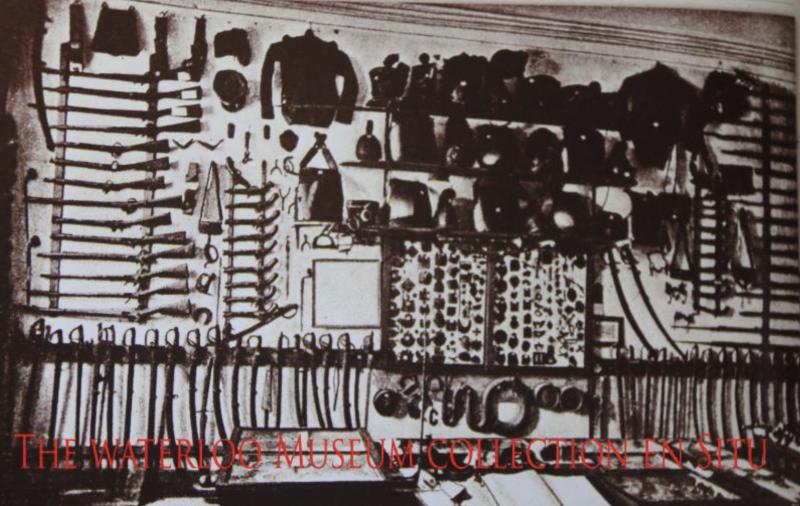A Beautiful Napoleonic Wars Scottish Officer's Sword, of a Grenadier Company Officer of The Regiment. Bears the Badge & Motto, Neme Me Impune Lacessit, No One Provokes Me with Impunity, of the Black Watch
Most attractive three bar, half basket, slotted hilt, with traditional GR cypher with above a grenade company officer's badge, with regimental ovoid insert of the Black Watch regt. A beautiful bespoke officer's sword, blade stamped by the maker's, Wooley & Deakin, the company name of the partnership in Birmingham from 1800 to 1804. It changed to add an additional partner in 1808. Triple wire bound grip in very good and complete condition.
Blade in very nice condition, and overall bright and devoid of surface age pitting. We show in the gallery the small close combat edge defensive blocking cuts present, that in our opinion, and of many others, including our late friend and colleague, Howard Blackmore of the Tower Armouries, should never to be removed, as they are deemed most honourable battle scars, and as every one will represent a defensive block to a slash that may have slain the defender, they should always be inviolate for posterity.
The regiment that fought with incredible distinction in the Peninsular war, Quatre Bras, and Waterloo.
The 1st battalion embarked for Portugal in August 1808 for service in the Peninsular War. At the Battle of Corunna in January 1809 it was a soldier of the Black Watch Highlanders who carried the mortally wounded General Sir John Moore to cover, and six more who carried him to the rear, but only after he had witnessed the victory in which the stout defence of the Black Watch played a major part. Moore's army was evacuated from Spain and the 1st Battalion of the Black Watch Highlanders went with them.
As the 1st battalion left, the 2nd battalion was dispatched from Ireland to Spain for service in the Peninsular War. The 2nd battalion fought at the Battle of Bussaco in September 1810 before falling back to the Lines of Torres Vedras. The 2nd battalion fought with great distinction at the Battle of Fuentes de Oñoro in May 1811, the siege of Ciudad Rodrigo in January 1812 and the bloody siege of Badajoz in March 1812 before returning home to recruit. The 1st battalion returned to the Peninsula in time to fight in the Battle of Salamanca in July 1812,the siege of Burgos in September 1812 and the Battle of Vitoria in June 1813. It then pursued the French Army into France and fought at the Battle of the Pyrenees in July 1813, the Battle of Nivelle in November 1813 and the Battle of the Nive in December 1813 before seeing action at the Battle of Orthez in February 1814 and the Battle of Toulouse in April 1814,
The Black Watch’s Waterloo started on the 16th of June 1815, 2 days before the famous battle was to take place! After Napoleon had escaped from Elba and convinced his army to go against the King of France and join him in releasing terror against the Anglo-Dutch.
On the 15th of June some of the officers and soldiers from the Black Watch performed at the Duchess of Richmond's Waterloo Ball in Brussels whilst the rest of the regiments prepared themselves for battle. Then news reached Wellington that Napoleon's armies were marching through France. In the early hours of the 16th of June the regiment left almost immediately with many of the officers still in their white dress knee-breeches to confront Napoleon, marching to the tune of "Hieland Laddie". After a gruelling journey in full marching order the Black Watch Highlanders arrived near to the French/ Belgium border at Quartre Bras by the Charleroi Road at about 3pm on the 16th of June and entered a 5 hour battle which may have been a factor in Wellington's Army finally beating Napoleon.
Napoleon had sent out a force to deal with the Anglo-Dutch at Quatre-Bras whilst he dealt with the Prussians at Ligny hoping that it would divide the 2 forces. The French commanded by Marshal Ney arrived along the Charleroi Road after having dealt with the 79th Highlander's offensive in the valley of Gemioncourt. The Brunswick Hussars were the 1st allied force at Quatre-Bras to attack the incoming French but failed miserably as most of the Brunswickers were raw troops and had little battle experience
The Black Watch were posted on a reverse slope in a line above the road. At first sight they were amazed at the advance of the French. As the French passed the Highlanders, the older soldiers of the regiment weren't satisfied and immediately opened fire and tried to restrain the French from advancing, they succeeded in causing a cessation of fire, but the Lancers were sitting to the rear of the cavalry and wheeled sharply round and advanced in admirable order directly upon the rear of the Black Watch who recognised their advancing position and formed square, but just as the 2 flank companies were running to form rear rank the lancers penetrated the square. Instead of the square being destroyed by the French the lancers were either bayoneted or taken prisoner. All further attempts by the French were repelled.
On a sadder note the Commanding officer of the regiment ( Lieut. Colonel Sir Robert Macara ) was killed and within the brief space of a few minutes the command of the regiment devolved upon 3 officers in succession, Lieut. Colonel Dick, who was severely wounded, Brevet Major Davidson, who was mortally wounded and Brevet Major Campbell who commanded the regiment during the remainder of the campaign.
The Black Watch pinned down Marshal Ney and prevented him from going to Napoleon's aid at Ligny which sealed Napoleon's fate and stopped Marshal Ney's men from wiping out Marshal Blucher's Prussian army at Old Fortwartz, before the Prussian and British armies could merge together.
The regiment lost 298 men at Quatre-Bras but were recognised in Wellington's dispatch of the battle. On the 18th of June 1815 they held the left centre of Wellington's position behind La Haye Sainte, against a French force of 13,000 bayonets. The Black Watch Highlander's on the day of Waterloo only lost 5 and had 45 injured. After the battle the wounded returned to their kind hosts in Brussels.
From the 17th Century to the mid 19th centuries the "Foot" or infantry regiments of the British and several other armies comprised ten companies; eight of them "Battalion" or "Centre" companies, and two "Flank Companies" consisting of one Grenadier and one Light or Light Infantry Company. In the United States, an Act of Congress made on 8 May 1792 directed that for every infantry battalion there should be one company of grenadiers, riflemen, or light infantry.
On occasion the grenadier and light companies could be "brigaded" together into separate grenadier and light infantry battalions for assaults or skirmishing respectively.
The source of the regiment's name is uncertain. In 1725, following the Jacobite rebellion of 1715, General George Wade was authorised by George I to form six "watch" companies to patrol the Highlands of Scotland, three from Clan Campbell, one from Clan Fraser of Lovat, one from Clan Munro and one from Clan Grant. These were to be "employed in disarming the rebels, preventing depredations, bringing criminals to justice, and hindering rebels and attainted persons from inhabiting that part of the kingdom." Francis Hindes Groome states in his Ordnance Gazetteer of Scotland (1901) that the watch was "embodied in a field in Aberfeldy in 1739". The force was known in Gaelic as Am Freiceadan Dubh, "the dark" or "black watch"
The last photo in the gallery shows a photograph of one section of the collection in the museum of Waterloo, taken in around 1900, showing all the weapons of Waterloo en situ, including all the protagonists {British, French, Prussian and Belgian muskets, swords, pistols, armour uniforms, etc}. The museum was founded and owned by a veteran of the 7th Hussars that fought at Waterloo
The basket's bars have had small, very accomplished contemporary, re-shaping and repairs etc. and the bullion knot restitched. No scabbard.
Code: 24684
1875.00 GBP


